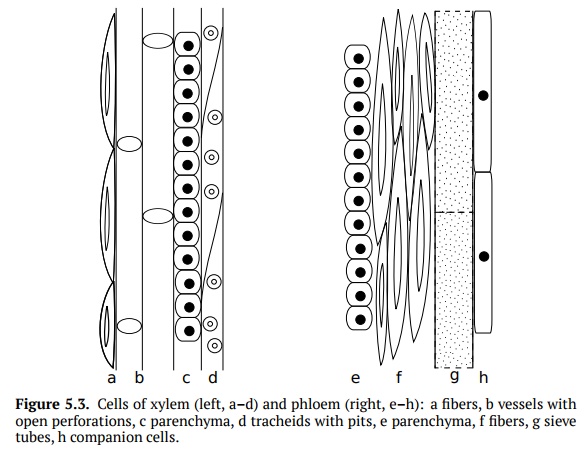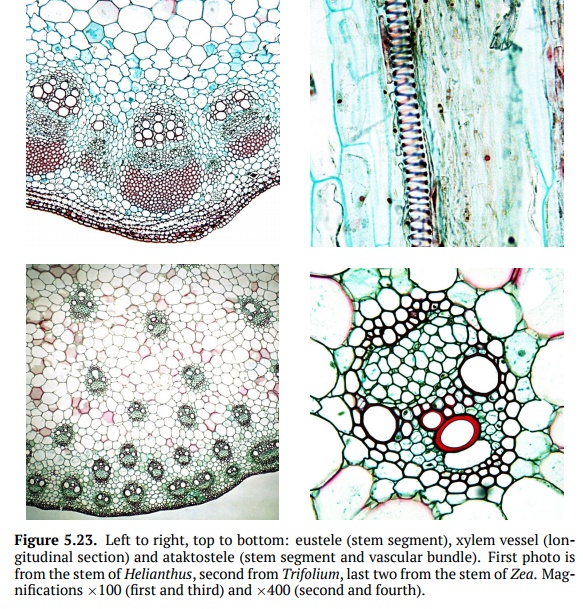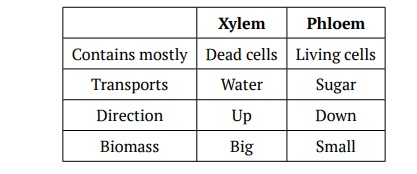Chapter: Introduction to Botany: Tissues and organs; How the Plant is built
Vascular Tissues
Vascular Tissues
Bigger plants escaped
from competition and performed effective metabolism. However, with all the
growth the plants went through, their size became too big for slow symplastic
plasmodesmata connections. Another, filter paper-like apoplastic transport was
also not powerful enough. The solution was to develop vascular tissues, xylem and phloem (Fig.5.3,Fig.5.23).

\The main functions of
xylem are the transportation of water and mechanical support. The xylem may be found either in a vascular
bundle or a vascular cylin-der. The three types of xylem cells are tracheary elements (these include tra-cheids and vessel members), fibers,
and parenchyma. Xylem elements,
exceptfor the parenchyma, are rich in lignin and are main components of wood.
Tra-cheids are closed on both ends and connected with pits whereas vessel members are more or less open and connects via perforations. Tracheids, vessel members
and fibers are dead cells. Xylem parenchyma, on the other hand, is alive.

Pits of tracheids
consist of a pit membrane and the torus in a center, there are no openings. The presence of tracheids
and/or vessel elements has evolution-ary significance. Vessels (made of vessel
members) are more effective; conse-quently, more “primitive” plants have more
tracheids whereas more “advanced” have more vessel members. As an example,
gymnosperms have only tracheids while most flowering plants have tracheids and
vessel members. Individual de-velopment also mimics this evolutionary trend.
Younger flowering plants have more tracheids whereas mature plants have more
vessel members. Primary xylem mostly has tracheids and vessels with scalariform
perforations whereassecondary xylem (which originates from cambium) consists
mostly of vessels with open perforations. The common name for secondary xylem
is wood.
It is a mistake to
think that tracheids are better than vessels. In fact, the main problem is
frequently not too slow but too fast water transport. Tracheids have an
advanced connection system (called torus) which has the ability to close pore
if the water pressure is too high and therefore more controllable. Leaking
would be less dangerous in tracheids. And in water-poor environments (like
taiga in winter), plants with tracheids will have the advantage. Contrary,
having vessels is like to have race car for ordinary life; only flowering plants
“learned” how to use them effectively.
Dead cells are useful
but hard to control. However, if xylem transport needs to be decreased, there
is a way. Xylem parenchyma cells will make tyloses
(“stoppers”) which will grow into dead tracheary elements and stop water if
needed. Many broadleaved trees use tyloses to lower xylem transport before the
winter.
The phloem generally occurs adjacent, or
right next to, the xylem, with the xylem facing the inner part of the plant and
the phloem facing the outer part of the plant. The main functions of the phloem
are the transportation of sug-ars and mechanical support. The four types of
phloem cells are: sieve tubecells, companion cells, fibers (the only dead cells in phloem), and parenchy-ma. Sieve tube cells of flowering plants have cytoplasm
flowing through perfora-tions (sieve plates) between cells but do not contain
nuclei. Companion cells will make proteins for them. However, in gymnosperms
and more “primitive” plants there are no companion cells at all, so sieve tube
cells do contain nuclei. This is comparable to red blood cells in vertebrates:
while mammals have them anu-cleate, erythrocytes of other vertebrates contain
nucleus. The secondary phloem generally has more fibers than the primary
phloem.
This small table
summarizes differences between xylem and phloem:

Related Topics